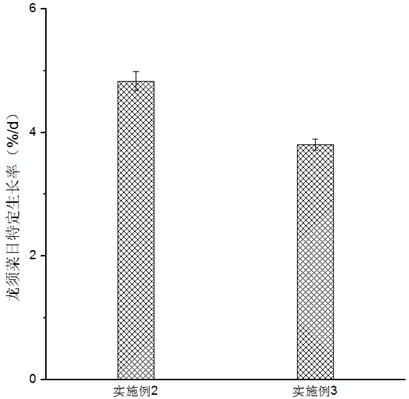A bioremediation technology for eutrophic water body
A bioremediation and eutrophication technology, which is applied in the field of habitat restoration, can solve the problems of affecting photosynthesis of plants in water, reducing water transparency, and supersaturation of dissolved oxygen, so as to improve photosynthesis efficiency, increase inhibition rate, and increase transcription level. Effect
- Summary
- Abstract
- Description
- Claims
- Application Information
AI Technical Summary
Problems solved by technology
Method used
Image
Examples
Embodiment 1
[0036] 1. A preparation method of sustained-release microspheres, comprising:
[0037] 1) Dissolve 23g of stevioside and 15g of (2R,3R)-dihydroquercetin in 1L of sterile seawater to obtain a mixed solution of stevioside and (2R,3R)-dihydroquercetin, and take 50g of alginic acid Sodium powder was dissolved in 1L of sterile seawater to obtain a viscous solution of sodium alginate, and after mixing the two evenly, a material colloid solution was obtained;
[0038] 2) Take 100g of calcium chloride and 40g of chitosan powder and dissolve them in 5L of 1.2% (m / v) acetic acid solution to make a fixative solution;
[0039] 3) Drop the material colloid solution in 1) into the fixative solution in 2) drop by drop. After the dropwise addition, let it stand for 50 minutes to obtain slow-release microspheres. Remove the fixative solution and wash the slow-release microspheres with deionized water for 3 times. Freeze dry under vacuum.
[0040] 2. A preparation method for immobilized composi...
Embodiment 2
[0052] A kind of method for asparagus enrichment culture:
[0053] Pro culture medium composition: N: NaNO 3 3.5g; P: NaH 2 PO 4 0.2723g; Fe–Solution: Fe(NH 4 ) 2 (SO 4 ) 2 •6H 2 O 0.17525g, Na 2 EDTA 0.165g; Metal Solution: Na 2 EDTA 0.25g,H 3 BO 3 0.285g, FeCl 3 •6H 2 O 0.0125g, MnCl 2 • 4H 2 O 0.0365g, ZnSO 4 •7H 2 O 0.0055g, CoCl 2 •6H 2 O 0.001g; H 2 O640mL.
[0054] Preparation of culture solution A: Dilute the Pro culture solution with 100 times the volume of seawater, add 12mg / L zingerone, and set HCO 3 - It is 35mg / L.
[0055] The seawater used for the cultivation of asparagus was taken from the vicinity of Tuandao Wharf in Jiaozhou Bay, with a salinity of 32 and a pH of 8.10. After filtering through a filter membrane with a pore size of 0.45 µm, sterilize with moist heat for 20 minutes, and let it stand for 24 hours to balance.
[0056] After the asparagus used in the experiment was cultured in the collected seawater for 10 days, healthy al...
Embodiment 3
[0058] No zingerone was added when the culture solution A was prepared, and the rest was exactly the same as in Example 2.
PUM
 Login to View More
Login to View More Abstract
Description
Claims
Application Information
 Login to View More
Login to View More - R&D
- Intellectual Property
- Life Sciences
- Materials
- Tech Scout
- Unparalleled Data Quality
- Higher Quality Content
- 60% Fewer Hallucinations
Browse by: Latest US Patents, China's latest patents, Technical Efficacy Thesaurus, Application Domain, Technology Topic, Popular Technical Reports.
© 2025 PatSnap. All rights reserved.Legal|Privacy policy|Modern Slavery Act Transparency Statement|Sitemap|About US| Contact US: help@patsnap.com



